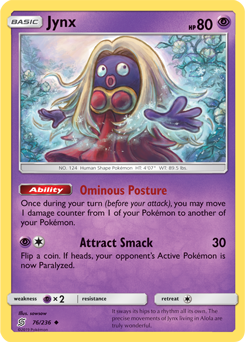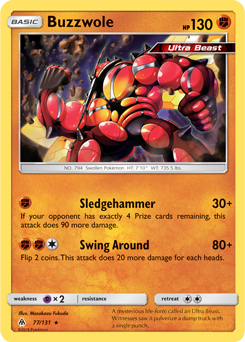About the Author
Hello readers! My name is Andrew Martin and I am excited to be bringing you all my first article for FlipSide Gaming. Before we get into the topics at hand, I would like to introduce myself. I am a competitive Pokémon TCG player from St. Louis, Missouri and have been playing the game since early 2017. Last season I was able to break out and achieve 6 consecutive day 2 finishes, including winning the Greensboro, North Carolina Regional Championship, as well placing in the top 64 of the North American International Championships which ranked me 19th in North America for the 2018-2019 season. Outside of Pokemon, I am a senior at Southern Illinois University Edwardsville finishing up my degree in Business Administration with a concentration in Computer Management Information Systems. Hopefully when I finish my degree, IRL events will kick back up because I miss the thrill of traveling and playing in big tournaments with my friends. In the meantime, I have enjoyed writing as well as watching the various Pokemon TCG Twitch streamers that are out there. That's probably enough talk about me, now let's get into the real content!
Introduction
In a time where in-person tournaments are slightly too risky to hold, the next best opportunity we have is utilizing Pokemon's online client. The Pokemon Company International (TPCi) has put a freeze on all sanctioned events around the world which is giving us one of the longest stretches without official tournaments in a long time. Fortunately, we have seen members of the community, as well as TCPi, set up tournaments over Pokemon Trading Card Game Online (PTCGO) in an attempt to keep the competitive season alive. Ultimately, this is where the scene has adapted and we are seeing many players enjoy participating in these online tournaments in lieu of the big events that would have been taking place IRL. While it is not the same, they are still exciting to watch and participate in.
As I am sure most are already aware, the weekend of June 13-14th was filled with Pokémon TCG action. We saw the conclusion of one huge online series and the beginning of another. Both the Limitless and Player's Cup Invitationals took place, giving us an entire weekend of event coverage. While both events were small due to the exclusivity of an invitational, the average skill level of players in the tournament was high. Each player had to earn their spot in one way or another, so the competition was fierce. Today we are going to be looking at the results of both tournaments and take a closer look at what decks took them down.
Limitless Invitational
This Limitless Invitational was the final tournament of the Limitless Online Series and required players to qualify by placing well in the other four qualifiers. Over 2000 players in total participated in this series and only 16 players were invited to the final showdown.
The tournament itself was set up in a double elimination bracket, which is not commonly used in the TCG. Basically, there are two brackets: one for winners and one for losers. Every player starts in the winners bracket and then either proceeds in that bracket if they win their round or gets demoted to the losers brackets for their next round if they lost. Once you get into the losers bracket, the pressure is on because if you lose in this bracket then you are eliminated from the tournament. This process continues until we have only one person remaining in both brackets and then they will face off in the grand finals, usually giving the undefeated player some sort of advantage. Double elimination can be kind of complicated, so if none of this made sense just know that if any player loses more than one round then they are out of the tournament.
The metagame itself was somewhat straight forward. This format has quite a few different tier one decks so trying to target just one in a field this small could backfire, meaning the play seemed to be: just take something consistent and hope for the best. However, we did see one deck that unexpectedly took down both sides of the bracket.
Top 4:
- Kevin Krueger – Spiritomb (winner)
- Luke Morsa - Spiritomb
- Azul Garcia Griego – Combo Zacian
- Aaron Friedman – PikaRom
Kevin's Spiritomb
Spiritomb (I.e “Doom Count” or “DoomTomb”) has been, at least to some degree, a dark horse in the recent meta. We've seen other Spiritomb variants succeed in the past Limitless Qualifiers, notably with Ross Cathon's ADP Spiritomb in Q1 and Andrew Wambolt Spiritomb + Ultra Beasts in Q4, but many were still uncertain if this deck was going to be a top contender of the weekend. Well, those doubts were proven wrong as we saw a Spiritomb mirror in the finals of the Limitless Invitational. While tricky to operate at times, this deck has great type coverage and options for dealing with the monstrous three prize behemoths that this format is dominated by. I would like to take a look at Kevin's list to highlight some of the most important cards.
Spiritomb
This card is interesting; needing damage counters placed upon it to deal heavy amounts of damage in return. With its ability “Building Spite”, it is able to rake up damage counters each turn to eventually be able to swing for enough damage to take OHKOs on larger pokemon. However, this might take four - five turns to set up with only placing single damage counters, so the deck utilizes Rainbow Energy, Hustle Belt, and UNM Jynx - which we will talk about next - to cheat extra damage counters and get Spiritomb's attack power up faster. Managing the damage counters in play is part of the skill it takes to operate this deck effectively and you always have to consider what responses your opponent could have to knocking out multiple, highly damaged, Spiritombs.
Jynx
This card acts as a linchpin for the deck. While Rainbow energy can help you cheat a single damage counter out, using Jynx's “Omnius Posture” ability, in conjunction with multiple Scoop Up Nets, gives you the flexibility and freedom to manage the placement of damage on your board. This card allows the deck to stockpile damage counters on bulkier pokemon as well and gives Spiritomb the ability to be aggressive in the early game. Needless to say, this card is very important to the deck's strategy and provides tons of support as a bench sitter.
Buzzwole
A staple of formats in the past, this card always seems to find viability whenever Yellow or Dark cards are prominent in the format. Sledgehammer acts as a very efficient way to deal with PikaRom, especially in conjunction with shrine, and can take cheap two prize knockouts on Dedenne-GX. Attacking with this card also alleviates some of the pressure on Spiritomb as they can freely stack up more damage counters on the bench.
Yveltal GX
This card is in here almost exclusively for the GX attack, which KO's the opponent's active pokemon if they have exactly four damage counters on it. This can be devastating for any VMAX or Tag-Team deck that now has to worry about their three prize pokemon being vulnerable to this attack. While getting the four damage counters in play might be tricky, there are a few options in the deck to accomplish this. Shrine of Punishment is one of the easiest ways to get damage counters in play on GX Pokemon, but can also work against this strategy if too many damage counters get placed. Galarian Zigzagoon with Scoop Up Net can also help pull off this GX attack by placing multiple damage counters in a turn. If all else fails, a Spiritomb with one damage counter on it swings for 40. Nevertheless, being able to instantly KO a VMAX or Tag-team for one energy is powerful and this card can help you squeeze through some of the largest Pokemon in the format.

Black Market Prism Star
This card acts as a “Life Dew” of sorts and can prevent our opponent from taking prizes when knocking out Spiritomb. While there are a few ways that the opponent could get around this, it's the moments when they can't that this card can generate an advantage. This is perhaps the most useful in any situation where you are trading KO's with other one-prize attackers. In a match up like Blacephalon UNB or the mirror, you have to worry about falling too far behind in this exchange, so having the option to prevent your opponent from taking prizes is a powerful tool. This card is perhaps most interesting in the mirror, where the effect can both help and hinder at the same time depending on what resources you have at your disposal. Either way, preventing your opponent from taking prizes can be devastating so using this card wisely can be game changing.
Players Cup Invitational
The Pokémon Players Cup marks the first “official” Pokémon tournament we have seen utilize their online client, PTCGO. It's funny; not that long ago, the idea of TCPi actually using PTCGO as a vehicle for a competitive tournament would have seemed impossible. Nevertheless, Pokemon has launched this virtual tournament circuit which is taking place in various phases over the summer. This weekend was the real kick-off event with 8 notable players being invited to compete in an invitational that awards the winner a spot in the final phase (top 16) of the Online Series. These games were recorded two weeks prior to airing and then streamed live over the weekend. While this might mean some of the lists might not have been the most up-to-date, we did see some unique ideas that I believe are going to help shape the metagame moving forward.
This tournament was almost as stacked as you could make it, with each player carrying their own fair share of accomplishments. The tournament was set up in a double elimination bracket, so each player had multiple shots at climbing their way through the bracket. Similar to the Limitless Invitational, the metagame itself was very straight forward. Most of the decks we saw were standard tier 1 decks, the notable exceptions being Spiritomb and Greens PikaRom which incidentally were the first two decks eliminated from the bracket. This is the exact same idea as what we discussed before; where consistency is going to carry a player farther than teching for certain matchups. We saw quite a few close sets towards the end, but Tord Reklev was able to come out on top, no surprises there.
Top 4:
- Tord Reklev – Dragapult VMAX (winner)
- Andrew Mahone – Blacephalon UNB
- Pablo Meza – PikaRom
- Michael Pramawat – Blacephalon UNB
Tord's Dragapult
If you know nothing about Tord's deck building style, it can be summarized in one phrase: “Consistency is King”. He has said many times that one of the most important qualities he looks for in a deck is its ability to execute the same strategy successfully over a multitude of games. While I could write a whole article in itself on what components influence this, to put it briefly his decks are built to do one or two things and do them every time. While this might seem too linear or boring, consistency is usually what contributes to a player performing well over the course of a tournament. Tord's build of Dragapult VMAX is very straight-forward, but very powerful nonetheless. Dragapult VMAX does so much on its own, and the approach Tord went with was not letting other techs get in the middle of setting up. The most interesting decision he made with this list is the exclusion of Switch, a four of inclusion in most Dragapult builds. A smart decision that appears to not have hindered the deck, and it allowed him to squeeze in extra consisty cards.
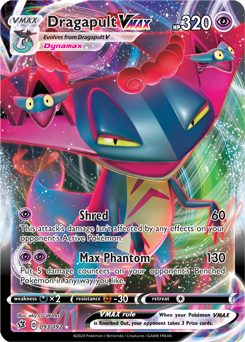
Dragapult VMAX
On the surface this card might not appear to be that great. With cards as large as 320 hp, 130 damage with only 50 damage counters on the bench might not scream a power house card. In this format, the math works out really well for this card to take control of games if it sets up properly. The 130 damage up front sets up most Pokemon GX and V cards to be knocked out on the following turn. Combine this with the small bench sitters like Jirachi TEU that are common in the format and you can set up turns where you are talking multiple knockouts in the same turn. Cards like Dedenne-GX are also easy prey and are simple to set up for cheap KOs in the late game.
Aside from the damage this card puts out on the field, having 320 hp is no laughing matter. It can be very challenging for most decks to one shot a VMAX, so the format is mostly centered around two shooting these huge attackers. This gives Dragapult more turns to set up a new attacker, as well as more time to get damage into play. Both of these give this a deck a unique advantage and are why this deck is performing well right now.
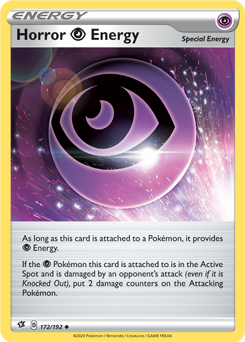
Horror Energy
Horror Energy is an obvious inclusion for a deck like this. Wherever the pokemon that this card is attached to gets attacked, the attacking pokemon takes some recoil damage in return. This card not only provides a useful energy attachment but also a way to cheat out more damage against your opponent when combined with Dragapult VMAX's tankiness.
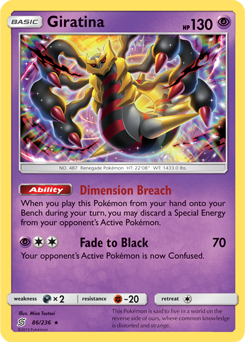
Giratina
An Enhanced Hammer of sorts, you can punish your opponent's special energy attachments with this card. Giratina is also reusable with the addition of Scoop Up Net, so you can even remove multiple energy cards in one turn. This is especially important in the mirror match, and even more so if your opponent does not run any extra way to accelerate energy. Any deck that is dependent on each attachment they make can be taken advantage of with this card and give the deck more time to take control of the board.

Shrine of Punishment
A point of contention in this build is the inclusion of Shrine of Punishment over Power Plant. Power Plant can be absurdly oppressive, especially when you are trying to slow down aggressive decks like Blacephalon UBR and PikaRom. However, Shrine damage can stack up very quickly if left unchecked. Ideally, Shrine of Punishment gives you an edge in the PikaRom deck just by the amount of GX Pokemon they have to put down. It can also help soften up Dedenne GX or Oricorio GX on the bench while you go after other bench sitters like a benched Jirachi or Oranguru. While I am uncertain if shrine is the optimal route to go, you can certainly make a case for it in this deck.
Metagame Moving Forward
Following these tournaments we can expect deckbuilders to keep refining and make lists more consistent. Dragapult, PikaRom, Zacian, and Spiritomb all seem like safe tier one contenders as the format keeps progressing. I would not be surprised to see Dragapult taking a higher share of the meta now with a streamline list like Tord's being available to players. Spiritomb is still a great deck, but there is a skill ceiling that will need to be overcome for a player to pilot this deck successfully, which incidentally will influence the amount of play it will see. We may also see Blacephlon pick up more with the success Andrew Mahone had in the Players Cup. In summary I do not expect any big shifts to happen in the tier lists, but for lists to keep adapting and getting ironed out.
What comes next?
It's already late June, meaning the end of this format is just around the corner. In a few weeks we will see the capping for qualification of the Player's Cup and the top 256 in most regions moving on to the Regional Qualifier. If you are one of the people currently grinding for that spot I wish you good luck!
Limitless has not announced any future events at the moment, but judging on the success of their past invitational, I would not be surprised to see them come out with new events in the future.
For those who are still interested in competing, but are not interested in participating in the Player's cup, I will link a few resources to check out for reliable online tournaments that are happening every week. While the format might seem to be winding down, and the post season blues coming closer, we still have a reasonable sized chunk of the quarter left before we move on to rotation. Speaking of rotation, the new set is going to be here before we know it so make sure you are keeping up with FlipSide gaming to get your Darkness Ablaze singles and sealed product when it drops in August.
JW Kriewall (aka FlexDaddyRighteous) video on online tournaments: https://www.youtube.com/watch?v=ooVsb9X_6AM
Links to various discords:
FlexDaddyRighteous - https://discord.gg/n99V9vf
Neil Pie Open - https://discord.gg/f84JtZ
PokeStats - https://discord.gg/nbJeqz
Conclusion
That wraps things up for this article. Having two great back to back tournaments was very refreshing to watch at home. No one could have imagined the competitive season would have turned out this way, but I am proud to watch the community rally and find new ways to overcome these challenges. With that said, thank you so much for reading this article. If you enjoy this type of content, make sure to check back to the FlipSide website for new content. If you have any thoughts on the Limitless or Players Cup Invitational, or have a favorite deck in the format that wasn't mentioned, please let me know in the comments! If you would like to keep up with me and my Pokemon journey, you can find me on Twitter @theskypillar. Once again, thank you so much for reading and I look forward to bringing you all new content very soon.







